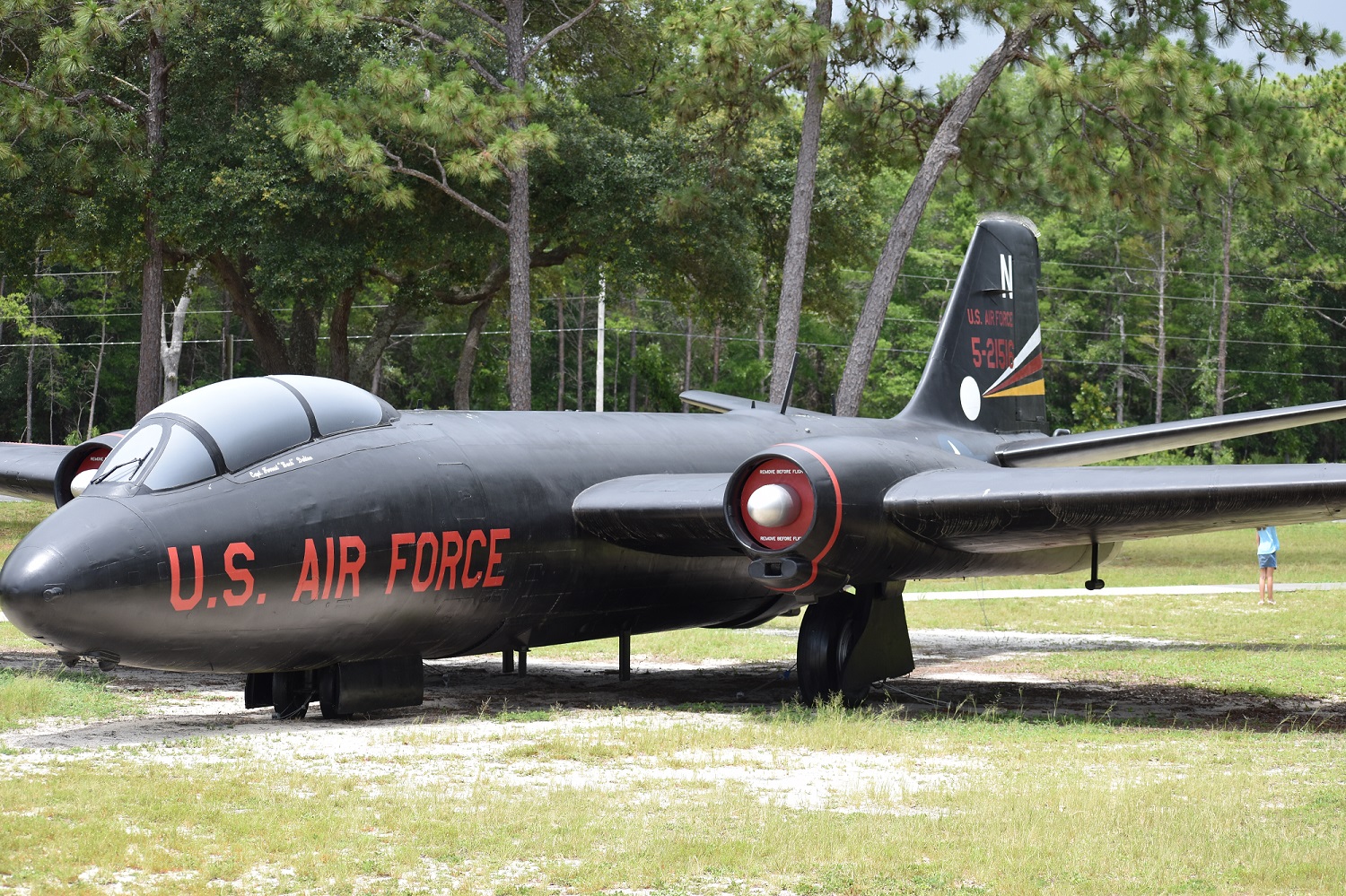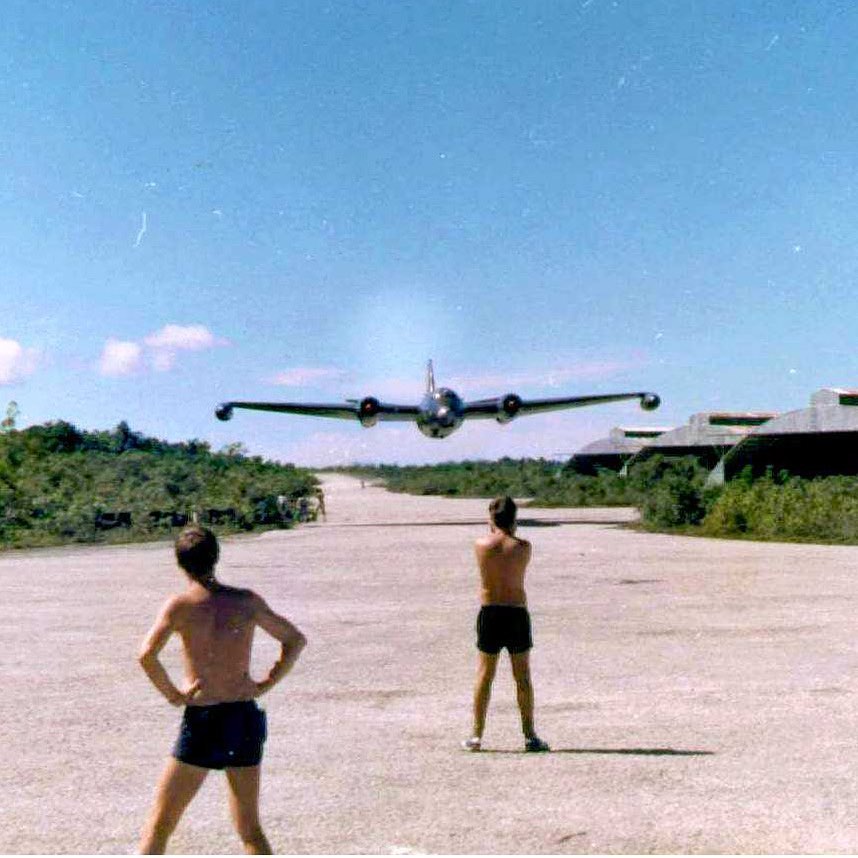Canberra Forever
In my normal travels around the Gulf Coast, I often find myself at the USAF Armament Museum outside of Eglin in NW Florida and one of the neater aircraft there, in my opinion, has always been a Martin EB-57B Canberra “Night Intruder,” SN 52-1516.

This EB-57B S/N 52-1516 was last flown by the 158th Defense Systems Evaluation Group (158 DSEG) stationed at Burlington, Vermont, and was retired in 1980 when the 158th switched to an Air Defense, Tactical Air Command fighter role, running Phantoms.
Resplendent in its black scheme, the ECM aircraft was one of 22 converted from a standard B-57B bomber in the late 1960s after the aircraft was withdrawn from its bombing role due to block obsolescence (58 were lost by the USAF in Vietnam, half to ground fire).
The B-57 was the first aircraft of foreign design to be chosen for U.S. production since 1918 and was based wholly on the English Electric Aviation Canberra— the RAF’s first jet-powered bomber. While Martin built 403 over here, English Electric cranked out an armada of 949 in both the UK and Australia.
Developed immediately after WWII, Canberra was an amazing aircraft for its day. Using rotating bomb bay doors, it could carry up to 8,000 pounds of ordnance including early atomic weapons such as the British Red Beard and the Mark 7 Thor fission bomb. It had a speed of 580 mph– Mach 0.88– on its twin Rolls-Royce Avon R.A. 3 engines and an 800-mile combat radius. The type set a slew of aviation records in the early 1950s, including the first nonstop unrefuelled transatlantic crossing by a jet, and setting a 70,310 ft altitude record. It could cover the Aldergrove – Gander Atlantic crossing in just over 4 hours.
When you consider Canberra first flew in 1949– less than a half-decade after VJ-Day– this was top-notch stuff.
However, the Canberra, though used in combat as a bomber as late as 1982– more on that in a second– its second life saw it become not only a great ECM plane but also serve in weather and photo recon. In fact, the final U.S. use of the Canberra by the USAF was in such a role while the Brits flew the PR.9 variant with No. 39 (1 PRU) Squadron until July 2006 on strategic reconnaissance and photographic mapping missions in Iraq and Afghanistan, a span of 57 years of operational use.
Speaking of the Brits and the Canberra, besides its U.S and Australian use, the type was exported to 13 countries including Argentina who bought 10 B.62 bombers and two T.64 trainers in the early 1970s– when they were already considered obsolete– replacing downright ancient WWII-era piston-engined Avro Lincolns in the bomber role.
Pressed into service in the Falkland Islands in 1982– some 40 years ago this month– eight flyable Argentine Canberras of Grupo 2 de Bombardeo made 54 sorties, with most combat missions being against British ground troops at night to help mitigate their age.
Nonetheless, two of those eight were swatted out of the sky:
- One, B-110, was splashed by a Sea Harrier on 1 May, losing both its crew.
- The second, B-108 was shot down by a Sea Dart from the Type 42 destroyer HMS Cardiff (D08) at an altitude of 39,000 feet on the next to the last day of the war, taking its pilot with it.
As far as I can tell, it was the last combat loss for the type.
Ironically, the RAF used Canberras in the conflict as well.
A pair of PR.9 photo recon aircraft were dispatched to Chile, where they were to operate with RAF crews under Chilean markings.

RAF Canberra PR 9 Photo Reconnaissance variant. Note the lack of wingtip tanks as seen on the U.S. Martin-made models
Ranging from Punta Arenas, at the very southerly-most tip of mainland South America, they could just make the Falklands and back and, as they could hang out comfortably above Angels 50, were immune to anything the Argies had to knock them down. The mission was hush hush and the stuff of a Tom Clancy novel.
From The Royal Air Force Museum Midlands:
The Canberras were to fly via RAF Wyton to Keflavik in Iceland), then to Gander in Newfoundland, Canada, from there to March AFB, California, Belize in Central America, and then skirting the west coast of South America down to a point 30 miles (50 km) south of the Peruvian/Chilean border to land at dawn on a deserted stretch of the Pan-American Highway, with the road marked out by ground personnel firing Very lights. There, an RAF Hercules, masquerading under Chilean Air Force markings, would have been waiting to pump fuel from its own tanks.
From there it would fly to its final destination at Punta Arenas. From there they would have flown reconnaissance missions over the Falklands.
An RAF Lockheed Hercules actually carried out a test landing on the Highway, with Chilean Air Force personnel on board to close the road. But the political risks to Chile and the UK were such that the project was abandoned when the aircraft was still in Belize.
Finally, it would be remiss to talk of Canberra and not mention the last (known) user: a trio of Martin-built WB-57Fs flown by NASAs for high-altitude scientific research (and the occasional Air Force-tasked overseas deployment).
As described by NASA Astronaut (and former Navy SEAL) Jonny Kim last month:
Why the WB-57? Because it provides high-altitude, pressure-suited operations to NASA astronauts in the space-equivalent zone (physiologically incompatible with human life). The WB-57 is a platform that enhances our understanding of the design elements behind pressure suits and the background required to operate procedures in a vehicle while being constrained to a pressure-suited environment. It’s a unique bird with a wingspan of 122′, max altitude of 65,000′ and powered by twin engines capable of 15.5k lbs of thrust each. Fun fact, the WB-57 was modified from the B-57 which was retired from the Air Force in 1983. When it’s not training astronauts, it’s performing research missions with its various science payloads.







When my father was stationed at Turner AFB (SAC) in the 60s there was a recon squadron there that flew B57s. Some of them had extremely long wings, about double the span of a standard B57.
In the recon version, the photographer sat squeezed into the nose cone. No heating, no ejection seat, best of luck!